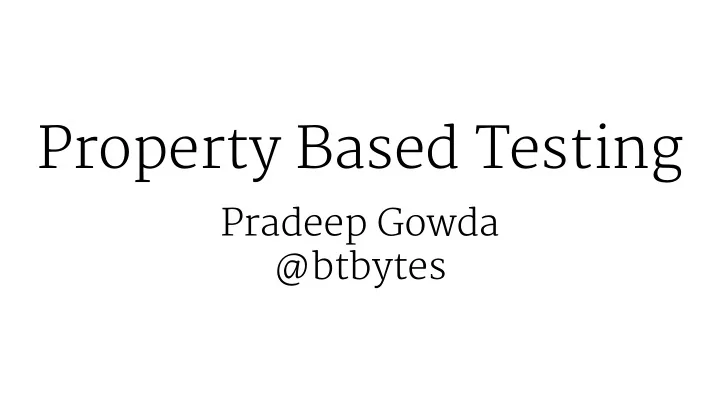

Property Based Testing Pradeep Gowda @btbytes
... ... ...
Tests are important for ...
Stability of the projects
Confidence to make changes (Refactoring)
Design (Huh! I thought that was captured in JIRA-124)
Regression Detection (upstream library devs said there are no breaking changes)
Testing is a great idea
... but also hard ...
Impediments to testing
Think of what you are testing (exact set of inputs and outcomes)
Testing => "Indirect" value
two weeks for "unit testing"
Can we write code to write tests for us ?
What is Hypothesis?
Hypothesis is a modern implementation of property based testing http://hypothesis.works
... runs your tests against a much wider range of scenarios than a human tester could...
... fj nding edge cases in your code that you would otherwise have missed .
It then turns them into simple and easy to understand failures
(so that your users don't have to discover "edge- cases")
Hypothesis integrates into your normal testing workflow
Installing pip install hypothesis
Writing tests A test in Hypothesis consists of two parts: 1. A function that looks like a normal test in your test framework of choice but with some additional arguments 2. and a @given decorator that specifies how to provide those arguments.
How does a property test look like? from hypothesis import given, strategies as st @given(st.integers(), st.integers()) def test_ints_are_commutative(x, y): assert x + y == y + x » @given turns test into a property » runs a number of times » ... with random input » ... generated by the strategy » reports failed examples
# ... continued ... @given(x=st.integers(), y=st.integers()) def test_ints_cancel(x, y): assert (x + y) - y == x @given(st.lists(st.integers())) def test_reversing_twice_gives_same_list(xs): # This will generate lists of arbitrary length (usually between 0 and # 100 elements) whose elements are integers. ys = list(xs) ys.reverse() ys.reverse() assert xs == ys @given(st.tuples(st.booleans(), st.text())) def test_look_tuples_work_too(t): # A tuple is generated as the one you provided, with the corresponding # types in those positions. assert len(t) == 2 assert isinstance(t[0], bool) assert isinstance(t[1], str)
How do property-based tests work? » Properties define the bevaviour » Focus on high level behaviour » Generate Random input » Cover the entire input space » Minimize failure case
Strategies » The type of object that is used to explore the examples given to your test function is called a SearchStrategy. » These are created using the functions exposed in the hypothesis.strategies module. » strategies expose a variety of arguments you can use to customize generation. >>> integers(min_value=0, max_value=10).example() 1
Strategies » Based on type of argument » NOT exhaustive -- failure to falsify does not mean true. » Default strategies provided » You can write your own generators
Adapting strategies # Filtering @given(st.integers().filter(lambda x: x > 42)) def test_filtering(self, x): self.assertGreater(x, 42) # Mapping @given(st.integers().map(lambda x: x * 2)) def test_mapping(self, x): self.assertEqual(x % 2, 0)
Sample of available stratgies » one_of » sampled_from » streams » regex » datetimes » uuids
Shrinking Shrinking is the process by which Hypothesis tries to produce human readable examples when it fj nds a failure - it takes a complex example and turns it into a simpler one.
Falsified example # two.py # A sample falsified hypothesis from hypothesis import given, strategies as st @given (st.integers(), st.integers()) def test_multiply_then_divide_is_same(x, y): assert (x * y) / y == x # Result:... falsifying_example = ((0, 0), {}) if __name__ == '__main__': test_multiply_then_divide_is_same()
Composing Strategies >>> from hypothesis.strategies import tuples >>> tuples(integers(), integers()).example() (-24597, 12566)
Composing and chaining # chaining @given(st.lists(st.integers(), min_size=4, max_size=4).flatmap( lambda xs: st.tuples(st.just(xs), st.sampled_from(xs)) )) def test_list_and_element_from_it(self, pair): (generated_list, element) = pair self.assertIn(element, generated_list)
import unittest import unittest class TestEncoding(unittest.TestCase): @given(text()) def test_decode_inverts_encode(self, s): self.assertEqual(decode(encode(s)), s) if __name__ == '__main__': unittest.main()
Hypothesis example database » When Hypothesis finds a bug it stores enough information in its database to reproduce it. » Default location $PRJ/.hypothesis/examples
Reproducing test failures
Provide explicit examples » Hypothesis will run all examples you’ve asked for first. » If any of them fail it will not go on to look for more examples. @given(text()) @example("Hello world") @example(x="Some very long string") def test_some_code(x): assert True
Reproduce test run with seed » You can recreate that failure using the @seed decorator
Health checks » Strategies with very slow data generation » Strategies which filter out too much » Recursive strategies which branch too much » Tests that are unlikely to complete in a reasonable amount of time.
Settings Changing the default behaviour from hypothesis import given, settings @settings(max_examples=500) @given(integers()) def test_this_thoroughly(x): pass
Available Settings » database -- " save examples to and load previous examples" » perform_health_check » print_blob » timeout » verbosity
Choosing properties for property-based testing » Different paths, same destination (eg: x+y == y+x ) » There and back again (eg: decode(encode(s)) == s ) » Transform (eg: set([1,2,3,4]) == set([2,3,41]) )
Choosing properties for property-based testing (2) » Idempotence (eg: uniq([1,2,3,1]) == uniq[(1,2,3)] == uniq[(1,2,3)] ) » The Test Oracle (Test an alternate/legacy/slow implementation) Source -- Choosing properties for property-based testing | F# for fun and profit
Thank you! read code -- http://hypothesis.readthedocs.io/en/latest/ usage.html
Recommend
More recommend